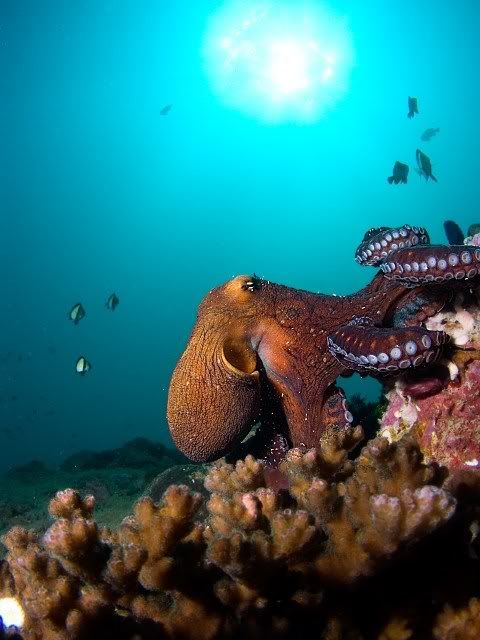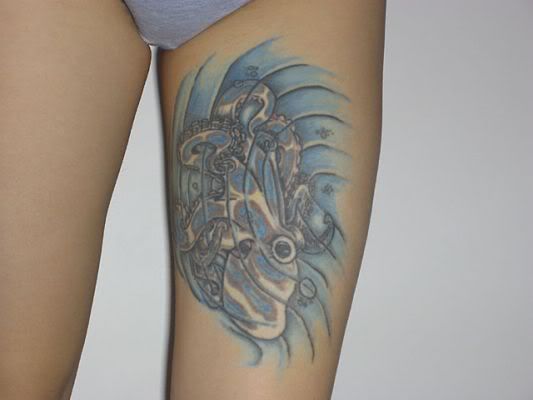Aristóteles y la ley del mar
Published Saturday, November 26, 2005 by Spyder....Crustaceans feed in like manner. They are omnivorous; that is to say, they live on stones, slime, sea-weed, and excrement-as for instance the rock-crab-and are also carnivorous. The crawfish or spiny-lobster can get the better of fishes even of the larger species, though in some of them it occasionally finds more than its match. Thus, this animal is so overmastered and cowed by the octopus that it dies of terror if it become aware of an octopus in the same net with itself. The crawfish can master the conger-eel, for owing to the rough spines of the crawfish the eel cannot slip away and elude its hold. The conger-eel, however, devours the octopus, for owing to the slipperiness of its antagonist the octopus can make nothing of it. The crawfish feeds on little fish, capturing them beside its hole or dwelling place; for, by the way, it is found out at sea on rough and stony bottoms, and in such places it makes its den. Whatever it catches, it puts into its mouth with its pincer-like claws, like the common crab. Its nature is to walk straight forward when it has nothing to fear, with its feelers hanging sideways; if it be frightened, it makes its escape backwards, darting off to a great distance. These animals fight one another with their claws, just as rams fight with their horns, raising them and striking their opponents; they are often also seen crowded together in herds. So much for the mode of life of the crustacean.
Molluscs are all carnivorous; and of molluscs the calamary and the sepia are more than a match for fishes even of the large species. The octopus for the most part gathers shellfish, extracts the flesh, and feeds on that; in fact, fishermen recognize their holes by the number of shells lying about. Some say that the octopus devours its own species, but this statement is incorrect; it is doubtless founded on the fact that the creature is often found with its tentacles removed, which tentacles have really been eaten off by the conger...
Aristotle -The History of Animals-
Dentro de la amplia obra que nos dejó Arístoteles encontramos varios tratados de biología, se dice que Aristóteles tenía a su cargo diversos pescadores y cazadores que le traían las muestras de animales con las que él luego hacía las observaciones. El texto esta en inglés porque alguien de buena fe ha colgado en internet el tratado en este idioma.
Aristóteles
Estagira 384 a.C. - Calcis 322 a.C.
Entre los filósofos más destacados de Occidente se encuentra Aristóteles, el hijo de Nicómaco, médico del rey macedonio Amintas II. A los 18 años se trasladó a Atenas para continuar su formación, ingresando en la Academia de Platón donde permaneció unos 20 años, hasta el fallecimiento del maestro. En ese momento decidió abandonar Atenas para vivir en una comunidad platónica organizada en Asso desde donde se marchó a Mitelene. En esta ciudad recibió la llamada de Filipo de Macedonia para educar a su hijo, Alejandro. Una vez el gran Alejandro accedió al trono macedonio, Aristóteles regresó a Atenas donde fundaría una escuela cercana al templo de Apolo Licio de donde tomará el nombre de Liceo. También se llamaría escuela peripatética ya que el maestro impartía algunas lecciones paseando. Los tranquilos años pasados en Atenas se vieron alterados a la muerte de Alejandro (323 a.C.) cuando el partido nacionalista acusaba al maestro de impiedad. Aristóteles abandonó la ciudad y se marchó a Calcis donde falleció al año siguiente. Conservamos una 50 obras y tratados de Aristóteles y algunos fragmentos, distinguiéndose cuatro grandes grupos: Escritos de lógica (Metafísica, Sobre la interpretación, Tópicos), Escritos de filosofía de la naturaleza (Sobre el alma, Sobre el cielo, Lecciones de física), Escritos de filosofía práctica (Etica a Nicómaco, Etica a Eudemo, Política) y Escritos de poesía (Poética y Retórica).
Labels: Literatura
Mitología del pulpo -La leyenda de los maoríes-
Published Friday, November 25, 2005 by Spyder.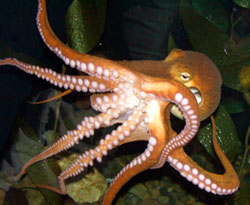 Los maoríes tienen una leyenda que cuente el como un pescador llegó a Nueva Zelanda persiguendo a un pulpo...
Los maoríes tienen una leyenda que cuente el como un pescador llegó a Nueva Zelanda persiguendo a un pulpo..."La leyenda cuenta que sus antepasados llegaron en sus canoas con soporte exterior , probablemente hacia el año 1350. Se dice que llegaron a Nueva Zelanda desde Hawaiki (quizás Tahití), como resultado de una visita anterior realizada por Kupe, un pescador de Hawaiki. Un día en que Kupe se hallaba pescando, un pulpo gigante mordió su cebo. Kupe persiguió al animal y cuando, finalmente, después de muchas penalidades, consiguió pescarlo se encontró con que estaba en el estrecho que separaba la isla Norte con la isla Sur. Descendió a tierra en la isla Sur y, después de una breve estancia allí, zarpó hacia la costa oeste de la isla Norte, partiendo finalmente hacia su lejano hogar desde una pequeña bahía, en North Auckland. Bautizo a esta isla con el nombre de Hokianga nui a Kupe, "Lugar del gran retorno de Kupe", cuando llegó a su hogar hablo a todo el mundo de las maravillas que le estaban esperando en las dos islas que había visitado. Después de algún tiempo los maorís, con una gran flota de canoas, cada una de las cuales transportaba 250 personas, se dispusieron a emigrar al nuevo país. Siguieron las instrucciones de navegación de Kupe y, según cuenta la leyenda, después de un heroico y peligroso viaje, llegaron a las costas de Nueva Zelanda".
Marisol Platamarisolplata@prodigy.net.mx
Labels: Mitología
Adivinanza
Published Thursday, November 24, 2005 by Spyder.
¿Cuál es el animal que tiene a toda la familia dispersa?
Me pregunto si será el pulpo...
Respuesta:
El pulpo (Porque el pulpo esta en el mar, la pulpa en la carnicería y el púlpito en la Iglesia)
Me pregunto si será el pulpo...
Respuesta:
El pulpo (Porque el pulpo esta en el mar, la pulpa en la carnicería y el púlpito en la Iglesia)
Labels: Humor
Noticia -Investigan 700 toneladas de pulpo sospechosas de tener salmonela-
Published Saturday, November 19, 2005 by Spyder.En la siguiente noticia se muestra uno de los problemas que se encuentra la Sanidad en relación con las partidas de pulpo. Se detienen unas partidas de pulpo por no estar en buen estado, y la mercancía se cambia de etiqueta y se intenta de nuevo reintroducir en España.
El error que se comete es doble porque por un lado uno no se puede fiar de las etiquetas con denominación de origen, y por otro lado la manipulación de embalajes supone que se rompa la cadena de frío del alimento congelado y que se produzca mucho más riesgo contra la salud.
Investigan 700 toneladas de pulpo sospechosas de tener salmonela
Vía El Mundo
18/11/2005
Los implicados podrían ser acusados de un delito contra la salud pública
JOSÉ CONTRERAS
JOSÉ CONTRERAS
CÁDIZ.- Setecientas toneladas de pulpo congelado, procedentes de puertos de Mauritania y Senegal, se encuentran inmovilizadas por orden judicial en los puertos de Algeciras (Cádiz), A Coruña y Alicante, según fuentes de la Subdirección General de Sanidad Exterior y del Ministerio de Economía y Hacienda en Madrid, ante la sospecha de que pudieran estar afectados por salmonela.
El pulpo tenía como destino final Mercamadrid, desde donde habría sido finalmente distribuido por toda España. De confirmarse la presencia de salmonela, los implicados en la operación mercantil podrían ser acusados de un delito contra la salud pública.
La orden de inmovilización ha partido del Juzgado de Instrucción Número 1 de Vigo, a raíz de la investigación abierta a primeros de año por el Servicio de Vigilancia Aduanera (SVA), donde este jueves nadie ofreció información al respecto, pese a que el asunto se encuentra en manos de la Justicia desde hace algún tiempo.
El valor en el mercado de los cefalópodos intervenidos podría rondar los siete millones de euros, según distintas fuentes del sector mayorista de pescados en Madrid. Las fuentes consultadas este jueves por EL MUNDO se negaron a facilitar la identidad del empresario responsable de la operación comercial, muy conocido en Mercamadrid.
Los análisis microbiológicos, según las mismas fuentes, están siendo realizados por orden judicial en el laboratorio del Ministerio de Sanidad y Consumo de Majadahonda y de ellos dependerá que se liberen o no los contenedores y que la mercancía pueda ser vendida con libertad en el mercado español.
Conforme a las fuentes antes citadas, 21 contenedores permanecen inmovilizados en cámaras frigoríficas del puerto de Algeciras, seis en Alicante y palés equivalentes a unos dos contenedores en el puerto de A Coruña. La mercancía se encuentra inmovilizada a la espera de los resultados analíticos.
Muestras contaminadas
Las pesquisas de los agentes del SVA se iniciaron a primeros de año gracias a una inspección rutinaria realizada por los técnicos de la Subdirección General de Sanidad Exterior en Galicia, una de cuyas funciones es el control y vigilancia de las condiciones higiénico sanitarias en el tráfico internacional de mercancías.
El género analizado era pulpo congelado y procedía de México. Los análisis revelaron, según las fuentes citadas, que estaba contaminado con salmonela, por lo que negaron la entrada de la mercancía y, en aplicación de la legislación vigente, ordenaron al mayorista su destrucción o devolución a lugar de origen.
El SVA, ante la sospecha de que esa partida pudiera intentar introducirse de nuevo en el mercado español, encargó a un grupo operativo el seguimiento internacional de la mercancía. Al parecer, el pulpo fue trasladado a un puerto no revelado de Africa, donde la reglamentación higiénicosanitaria no es tan estricta como en la Unión Europea. Allí, la mercancía pudo 'dormir', según la fuente citada, durante varios meses. Luego, al parecer, fue descongelada, pudo recibir un tratamiento químico especial y fue cambiada de embalaje para luego ser reenviada a España.
A su llegada a las instalaciones portuarias de Algeciras, Alicante y A Coruña -etiquetado como mercancía procedente de Senegal y Mauritania- y tras la investigación realizada por el SVA, los técnicos de los respectivos puestos de inspección fronteriza abrieron los contenedores para su investigación y extrajeron algunas muestras, por orden del juez, para determinar el grado de salubridad de las mismas. Las muestras fueron tomadas tanto en el fondo de las cajas como en su superficie para una mayor garantía.
Pulpos en la isla de Porquerolles
Published Friday, November 18, 2005 by Spyder.Situada en la zona de la Costa Azul la isla de Porquerolles, y la isla de Port-Cros, ambas encuadradas en las zonas de Parques Nacionales franceses. Las aguas de esas zonas contienen una buena cantidad de octópodos.
Para ir hasta Porquerolles o a Port-Cross

Protection
Aucune
Biologie
Le poulpe est un mollusque céphalopode,dont les plus gros individus mesurent environ 50 à 80cm. Les huit bras sont munis de deux rangées de ventouses sur la face inférieure. Le corps est lisse ou présente des aspérités et sa couleur est très variable en fonction de l’humeur de l’animal. Le poulpe vit dans les herbiers et les zones rocheuses depuis les petits fonds et jusqu’à 100 mètres de profondeur. Il est principalement nocturne et passe la journée dans un abri. Il se nourrit de mollusques, crustacés et poissons. Sa bouche en forme de bec de perroquet lui permet de broyer la coquille de ses proies. Après l’accouplement, la femelle pond de très nombreux œufs qu’elle surveille sans s’alimenter pendant deux mois jusqu’à l’éclosion puis meurt.
Caractéristiques
Lorsqu’il se sent menacé, le poulpe est capable de projeter un nuage d’encre qui le masque aux yeux de ses prédateurs. Les abris des poulpes se repèrent facilement grâce aux coquilles et autres restes de repas qui sont abandonnés à proximité de celui-ci !
Labels: Pesca
La ciudad de los pulpos
Published Thursday, November 17, 2005 by Spyder.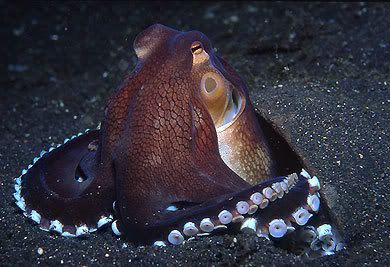
Debo admitir que durante nuestros trabajos en el barco griego hundido en el Grand-Congloué se produjeron algunos accidentes cuyas víctimas fueron nuestros amigos los pulpos. Los buceadores trabajaban el día entero para liberar la carga con una potente chupadora, en condiciones difíciles, cegados por nubes de lodo. Los pequeños pulpos residentes, molestos por este zafarrancho, se dejaban a veces alcanzar por la chupadora y eran lanzados sin miramientos a 50 metros más arriba. Varias veces llegaron entre los restos del barco formas viscosas y enredadas, grises o rojizas, provistas de tentáculos y ventosas. Pues sí, pulpos chupados por la máquina infernal salían de ella bastante malparados. En la isla de Porquerolles, cerca de Tolón, la bahía de Alicastre ofrece un panorama muy diferente al de la costa recortada de la región marsellesa. Sin embargo, es aquí donde nos topamos con una verdadera ciudad de pulpos, de grandes dimensiones y apasionante de explorar. Cuando llegamos, dirigidos por mi amigo Frédéric Dumas, que la había descubierto, creímos que se trataba de una broma pesada; por muy decidido que esté a adaptarse, un pulpo jamás podría vivir en este fondo liso, cubierto de lodo y de arena. Sin embargo, Dumas no nos había engañado: aquella zona estaba sembrada de baldosas de piedra tallada, sin duda restos de un naufragio, y los ingeniosos octópodos habían imaginado una brillante estrategia para poder sacarles partido. El azar había hecho caer las baldosas a cierta distancia las unas respecto de las otras. Era un hecho positivo para los pulpos, cuyo temperamento es solitario. Varios de ellos consiguieron levantar una loseta y atrancarla con algunas piedras formando un ángulo inclinado. Se convirtieron en casas de lujo para los mayores. Los otros se tuvieron que contentar con excavar una galería de 50 centímetros de longitud debajo de sus baldosasa. Acumularon delante de la entrada de sus guaridas piedras y objetos diversos recogidos a veces muy lejos de allí. Algunos de estos objetos estaban adornados con anémonas o con ceriantarios, constituyendo así una especie de jardín. Con un tentáculo rodeando esta pila, los pulpos nos esperaban; cuando nos acercábamos recogían esta acumulación de objetos como quien cierra la puerta.
Jacques Yves-Cousteau
Los secretos del marJacques Yves-Cousteau
Labels: Comportamiento
Arte y pulpos -Ouka Leele-
Published Wednesday, November 16, 2005 by Spyder.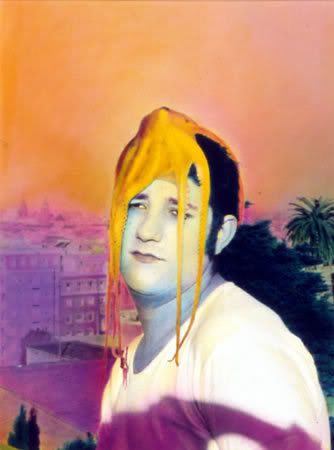
Galería de la fotógrafa española Ouka Leele en Photogaleria
Biografía via El Incorformista
Ouka Lele es una de las fotógrafas más prestigiosas de España. Nació en Madrid en Junio de 1957. Su verdadero nombre es Bárbara Allende Gil de Biedma, y surgió como artista de la «movida» madrileña de primeros de los ochenta, con la que también se dieron a conocer nombres como Alaska, Pedro Almodóvar y grupos como «Radio Futura» o «Nacha Pop». Tomó su sobrenombre de una estrella de un mapa celeste imaginario inventado por «El Hortelano», otro de los personajes de la «movida».Ha recorrido el planeta mostrando la belleza de su obra desde París y Nueva York hasta Sao Paulo.
Biografía via El Incorformista
Ouka Lele es una de las fotógrafas más prestigiosas de España. Nació en Madrid en Junio de 1957. Su verdadero nombre es Bárbara Allende Gil de Biedma, y surgió como artista de la «movida» madrileña de primeros de los ochenta, con la que también se dieron a conocer nombres como Alaska, Pedro Almodóvar y grupos como «Radio Futura» o «Nacha Pop». Tomó su sobrenombre de una estrella de un mapa celeste imaginario inventado por «El Hortelano», otro de los personajes de la «movida».Ha recorrido el planeta mostrando la belleza de su obra desde París y Nueva York hasta Sao Paulo.
Pulpos en el cielo -Stella Sierra-
Published Sunday, November 13, 2005 by Spyder.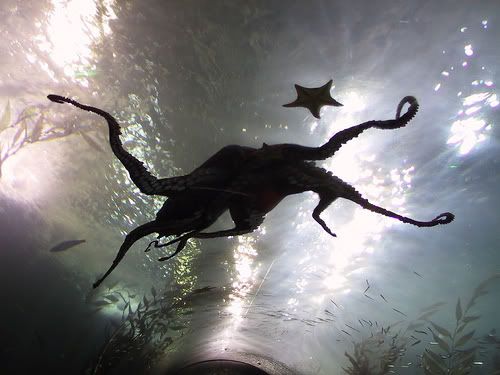
Fotografía tomada por greenwithevil en algún rincón de la costa Californiana.
…¡Bajamar, bajamar! Tiembla la ola
de movimiento en círculo.
Grita el viento enredado dentro del caracol.
Abre el pulpo los brazos y la rosa coral.
Y, jadeante la estrella, quiebra el cristal -de sol, de sal y luna-
para enlazar tu seno con el cielo…
Stella Sierra –Poema del mar en tres movimientos-
Stella Sierra (1917)
Nació en la ciudad de Aguadulce, el 5 de julio de 1917. Realizó sus estudios secundarios en el Colegio Internacional María Inmaculada y estudios superiores en la Universidad de Panamá , en donde obtiene el título de Profesora de Español 1954. En 1942 ganó el primer premio del Concurso Ricardo Miró con su obra en verso Sinfonía Jubilosa. Sorprendió entonces "la propiedad de su lenguaje, la pureza de su concepción, su dignidad estética," cualidades que ha conservado en su obra posterior.
Ha publicado Canciones de Mar y Luna, (1944) Sinfonía Jubilosa en doce sonetos (1944), Libre y Cautiva (1947), Cinco poemas. Cada una de estas obras representan una evidente renovación técnica.
Labels: Camisetas, Monstruos marinos, Pulpos celestes
Mitología del pulpo -Samoa- Ceremonias en Pulemei-
Published Saturday, November 12, 2005 by Spyder.La mayoría de los archipiélagos de la Polinesia están compuestos por centenares de pequeñas islas, el de Samoa en cambio tiene solo dos grandes islas Upolu y Savaii y un par de pequeños islotes. En Savai encontramos la península de Falealupo, la punta más occidental de Samoa. Un poco más al sur está el cabo Mulinuu, que era considerado como el fin del mundo (una especie de Finisterre). Los samoanos pensaban que más allá de aquel mundo empezaba el mundo de los espíritus.
En Savaii, también se encuentra la pirámide de Pulemei, el monumento megalítico más grande de la polinesia, una pirámide que está completamente cubierta de vegetación. Allí a veces se hacen ceremonias, en las que se encienden ocho fuegos distantes, que simbolizan los ocho tentáculos del pulpo, puesto que la leyenda Samoana cuenta que el pulpo es la manifestación terrenal del Dios. Los Samoanos creen que Fe’e Dios de la guerra a veces era un pulpo gigante capaz de extender sus tentáculos en las lejanas esquinas del mundo. Y que Na Kika fue el pulpo que emergió la Tierra del mar (lo dije cuando hablé de las islas Kiribati) y separó los cielos de la tierra.
En Savaii, también se encuentra la pirámide de Pulemei, el monumento megalítico más grande de la polinesia, una pirámide que está completamente cubierta de vegetación. Allí a veces se hacen ceremonias, en las que se encienden ocho fuegos distantes, que simbolizan los ocho tentáculos del pulpo, puesto que la leyenda Samoana cuenta que el pulpo es la manifestación terrenal del Dios. Los Samoanos creen que Fe’e Dios de la guerra a veces era un pulpo gigante capaz de extender sus tentáculos en las lejanas esquinas del mundo. Y que Na Kika fue el pulpo que emergió la Tierra del mar (lo dije cuando hablé de las islas Kiribati) y separó los cielos de la tierra.
Labels: Mitología
Mitología del pulpo -Samoa- Le Fe'e-
Published by Spyder.Los Samoanos tienen una mitología rica, creen que sus islas fueron creadas por el dios Tagaoloa, y tiene diversos panteones dedicados a otros diose, incluyendo a Fe’e el dios de la guerra y que los Samoanos representa como un enorme pulpo. Fe’e vive bajo el mar y con sus tentáculos es capaz de alcanzar la isla de una punta a otra. Un poco más sobre Fe’e:
Le Fe'e, The cuttle-fish (Octopus)
Vía Samoan Sensation
1. This was a war-god said to have been brought by a chief called Tapuaau, who swam hither from Fiji with his cuttle-fish. When taken into a house it showed a special fondness for a piece of white native cloth by stretching over to it, and hence this white cloth became an emblem of the god, and his worshippers in going to battle were known by white turbans, which they thought would please the god and be a defence against the enemy.
Before starting all assembled in the public place of the village, and one of the priests prayed as follows :-
Le Fe'e e! faafofoga mai ia0 au o Fale le a tulai atu nei. Le Fe'e e! au mai ia ou mumu fuaSei tau a'i le taua nei.
Which may be translated as follows :-0 Fe'e! listen - I am Fale who now stand up - O Fe'e! give us your red flaming rage with which to fight this battle.
All listened carefully to the enunciation of this prayer by the priest, for if he was observed to stutter in a single word it was a bad omen.
The Fe'e was also supposed to be present in the white shell of the Cyproea ovula; hence a string of these shells was suspended in the house of the priest, and were supposed to murmur, or "cry", when war was determined on. The colour of the shells was also watched. A clear white was a good omen, but if they looked dark and dingy it was a bad one.
The movements of the cuttle-fish at sea were also looked after at war-times. If seen near the shore when the people were mustering for battle it was a good sign; if far off the reverse.
2. In one place the Fe'e was a general village god, whose province was not confined to war. The month of May was sacred to his worship, No traveller was then allowed to pass through the village by the public road; nor was any canoe allowed in the lagoon off that part of the settlement. There was great feasting, too, on these occasions, and also games, club exercise, spear-throwing, wrestling, etc.
A new temple was at this time erected, to the material of which every man, woman, and child contributed something, even if only a stick or a reed of thatch. Some were drafted off to put up the house, and the rest commenced to fight in real earnest, and settle any old grudges with each other. He who got the most wounds was set down for special favours from the god. With the completion of the temple the fighting ended, and that was to suffice for the year. A quarrel of neighbours at any other time, and rising to blows, was frowned upon by the god Fe'e, because it was not left till next year and temple-building day.
In another district three months were sacred to the worship of the Fe'e. During that time any one passing along the road, or in the lagoon, would be beaten, if not killed, for insulting the god. For the first month torches and all other lights were forbidden, as the god was about and did not wish to be seen. White turbans were also forbidden during the festivities, and confined to war. At this time, also, all unsightly projecting burdens-such as a 1og of firewood on the shoulder-were forbidden, lest it should be considered by the god as a mockery of his tentacula.
The priest at this place had a large wooden bowl, which he called lipi, or sudden death. This was another representative of the god, and by this the family had no small gains. In a case of stealing, fine mats or other gifts were taken by the injured party to the priest to curse the thief and make him i11. The priest would then sit down with some select members of the family around the bowl representative of the god, and pray for speedy vengeance on the guilty; then they waited the issue. These imprecations were dreaded. Conscience stricken thieves, when taken ill, were carried off by their friends on a litter and laid down at the door of the priest, with taro, cocoa-nuts, or yams, in lieu of those confessed to have been stolen; and they would add fine mats and other presents, that thc priest might pray again over the death-bowl, and have the sentence reversed.
There is a story that the cuttle-fish gods of Savaii were once chased by an Upolu hero, who caught them in a great net and killed them. They were changed into stones, and now stand up in a rocky part of the lagoon on the north side of Upolu. For a long time travelling parties from Savaii felt eerie when they came to the place-did not like to go through between the stones, but took the outside passage.
Another fragment makes out that a Savaii Fe'e married the daughter of a chief on Upolu, and for convenience in coming and going made a hole in the reef, and hence the harbour at Apia. He went up the river also at that place, and built a stone house inland, the "Stonehenge" relics of which are still pointed out, and named to this day" the house of the Fe'e." In time of war he sent a branch drifting down the river as a good omen, and a sign to the people that they might go on with the war, sure of driving the enemy.
3. In some instances the Fe'e was a household god only. If any visitor caught a cuttle-fish and cooked it, or if any member of that family had been where a cuttle-fish was eaten, the family would meet over the case, and a man or woman would be selected to go and lie down in a cold oven, and be covered over with leaves, as in the process of baking, and all this as a would-be or mock burnt-offering to avert the wrath of the god. While this was being done the family united in praying: "0 bald-headed Fe'e! forgive what has been done-it was all the work of a stranger." Failing such signs of respect and humility, it was supposed the god would come to the family, and cause a cuttle-fish to grow internally, and be the death of some of them.
Before starting all assembled in the public place of the village, and one of the priests prayed as follows :-
Le Fe'e e! faafofoga mai ia0 au o Fale le a tulai atu nei. Le Fe'e e! au mai ia ou mumu fuaSei tau a'i le taua nei.
Which may be translated as follows :-0 Fe'e! listen - I am Fale who now stand up - O Fe'e! give us your red flaming rage with which to fight this battle.
All listened carefully to the enunciation of this prayer by the priest, for if he was observed to stutter in a single word it was a bad omen.
The Fe'e was also supposed to be present in the white shell of the Cyproea ovula; hence a string of these shells was suspended in the house of the priest, and were supposed to murmur, or "cry", when war was determined on. The colour of the shells was also watched. A clear white was a good omen, but if they looked dark and dingy it was a bad one.
The movements of the cuttle-fish at sea were also looked after at war-times. If seen near the shore when the people were mustering for battle it was a good sign; if far off the reverse.
2. In one place the Fe'e was a general village god, whose province was not confined to war. The month of May was sacred to his worship, No traveller was then allowed to pass through the village by the public road; nor was any canoe allowed in the lagoon off that part of the settlement. There was great feasting, too, on these occasions, and also games, club exercise, spear-throwing, wrestling, etc.
A new temple was at this time erected, to the material of which every man, woman, and child contributed something, even if only a stick or a reed of thatch. Some were drafted off to put up the house, and the rest commenced to fight in real earnest, and settle any old grudges with each other. He who got the most wounds was set down for special favours from the god. With the completion of the temple the fighting ended, and that was to suffice for the year. A quarrel of neighbours at any other time, and rising to blows, was frowned upon by the god Fe'e, because it was not left till next year and temple-building day.
In another district three months were sacred to the worship of the Fe'e. During that time any one passing along the road, or in the lagoon, would be beaten, if not killed, for insulting the god. For the first month torches and all other lights were forbidden, as the god was about and did not wish to be seen. White turbans were also forbidden during the festivities, and confined to war. At this time, also, all unsightly projecting burdens-such as a 1og of firewood on the shoulder-were forbidden, lest it should be considered by the god as a mockery of his tentacula.
The priest at this place had a large wooden bowl, which he called lipi, or sudden death. This was another representative of the god, and by this the family had no small gains. In a case of stealing, fine mats or other gifts were taken by the injured party to the priest to curse the thief and make him i11. The priest would then sit down with some select members of the family around the bowl representative of the god, and pray for speedy vengeance on the guilty; then they waited the issue. These imprecations were dreaded. Conscience stricken thieves, when taken ill, were carried off by their friends on a litter and laid down at the door of the priest, with taro, cocoa-nuts, or yams, in lieu of those confessed to have been stolen; and they would add fine mats and other presents, that thc priest might pray again over the death-bowl, and have the sentence reversed.
There is a story that the cuttle-fish gods of Savaii were once chased by an Upolu hero, who caught them in a great net and killed them. They were changed into stones, and now stand up in a rocky part of the lagoon on the north side of Upolu. For a long time travelling parties from Savaii felt eerie when they came to the place-did not like to go through between the stones, but took the outside passage.
Another fragment makes out that a Savaii Fe'e married the daughter of a chief on Upolu, and for convenience in coming and going made a hole in the reef, and hence the harbour at Apia. He went up the river also at that place, and built a stone house inland, the "Stonehenge" relics of which are still pointed out, and named to this day" the house of the Fe'e." In time of war he sent a branch drifting down the river as a good omen, and a sign to the people that they might go on with the war, sure of driving the enemy.
3. In some instances the Fe'e was a household god only. If any visitor caught a cuttle-fish and cooked it, or if any member of that family had been where a cuttle-fish was eaten, the family would meet over the case, and a man or woman would be selected to go and lie down in a cold oven, and be covered over with leaves, as in the process of baking, and all this as a would-be or mock burnt-offering to avert the wrath of the god. While this was being done the family united in praying: "0 bald-headed Fe'e! forgive what has been done-it was all the work of a stranger." Failing such signs of respect and humility, it was supposed the god would come to the family, and cause a cuttle-fish to grow internally, and be the death of some of them.
Labels: Mitología
Fotografías de pulpos -Cielo azul-
Published Friday, November 11, 2005 by Spyder.Pulpos Vs Submarinistas
Published Thursday, November 10, 2005 by Spyder."El pulpo, aunque parezca mentira, era uno de los peores enemigos del buzo pero no por su agresividad ni por su tamaño ni su gran fuerza, sino por su curiosidad, un pulpo pequeñito era capaz de crear un grave problema a los buzos. Debido a su curiosidad se acercaban a la válvula de desalojo de aire, situada en la parte posterior de la escafandra a observar las burbujas que salían. El problema surgía cuando un pulpo obstruía dicha válvula, esto hacía que el aire no se pudiera desalojar y en un instante el traje se hinchaba como un globo, los brazos se ponían en cruz y las piernas abiertas y el buzo salía a toda velocidad hacia la superficie, una subida en globo de este tipo podía tener graves consecuencias.En 1950 uno de los buzos que trabajaba en la construcción del Puerto de Palma de Mallorca, Juan Torres, pudo comprobar en su piel el susto que un pulpo de pequeño tamaño, era capaz de darle al taponarle la válvula de desalojo, gracias a Dios ese día no ocurrió nada grave".
Daniel Fandos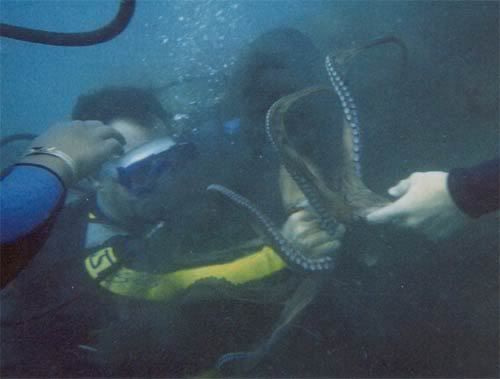
Labels: Pesca
Octopus Stencil -Cartel contra el bloqueo de Cuba-
Published Wednesday, November 09, 2005 by Spyder.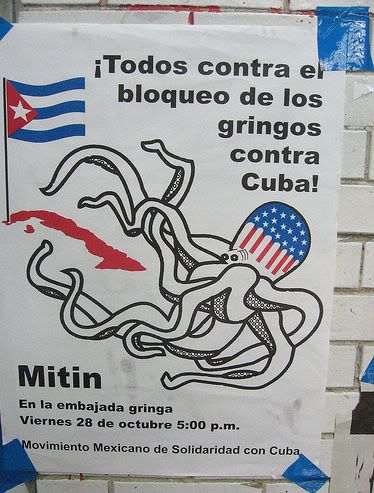 No me cae bien Fidel Castro -para que negarlo-, y espero que cuando deje el poder en Cuba se abra una etapa de trasición que acabe en una democracia de pleno derecho. Una democracia donde se acaben las censuras. En definitiva una sociedad libre donde el estado luche por el bienestar de sus ciudadanos, y aunque el modelo a instaurar inevitablemente será capitalista, espero que se intenten no cometer los mismos errores en los que los otros países nos vemos ya inmersos, y donde no vamos a negarlo, la diferencia entre ricos y pobres a veces resulta hasta ofensiva.
No me cae bien Fidel Castro -para que negarlo-, y espero que cuando deje el poder en Cuba se abra una etapa de trasición que acabe en una democracia de pleno derecho. Una democracia donde se acaben las censuras. En definitiva una sociedad libre donde el estado luche por el bienestar de sus ciudadanos, y aunque el modelo a instaurar inevitablemente será capitalista, espero que se intenten no cometer los mismos errores en los que los otros países nos vemos ya inmersos, y donde no vamos a negarlo, la diferencia entre ricos y pobres a veces resulta hasta ofensiva.Pero el bloqueo a Cuba es absurdo, porque lo único que se consigue así es que la inmensa mayoría de la sociedad cubana sufra. Y que encima a Fidel le sirva de excusa para enrocarse más en sus posiciones. Puestos a bloquear, seguro que habrían decenas de países por los que deberían de haber más motivos de bloqueo que la propia Cuba.
Hay una web dedicada a oponerse al bloqueo de Cuba. De todas maneras pongo un artículo bastante revelador de donde está la ONU y donde está EEUU.
179 países votan en la ONU contra el bloqueo a Cuba
• La Resolución presentada por la Isla sólo recibió tres votos en contra: EE.UU., Israel e Islas Marshalls, y dos abstenciones
4 de noviembre de 2005
NACIONES UNIDAS (PL).- La Asamblea General de la ONU se pronunció este 4 de noviembre por abrumadora mayoría por poner fin al bloqueo económico, comercial y financiero impuesto por Estados Unidos contra Cuba.
Una resolución adoptada aquí al respecto obtuvo la cifra récord de 179 votos a favor, los únicos en contra de Estados Unidos, Israel e Islas Marshalls y solamente dos abstenciones.
El pronunciamiento recuerda las declaraciones formuladas por los jefes de Estado o de gobierno en las Cumbres Iberoamericanas relativas a la necesidad de eliminar la aplicación unilateral de medidas de carácter económico y comercial que afecten el libre desarrollo del comercio internacional.
También expresa preocupación porque continúan la promulgación y aplicación de leyes y disposiciones como la estadounidense "Helms-Burton", que afectan la soberanía de otros Estados, los intereses legítimos de entidades y personas bajo su jurisdicción, la libertad de comercio y navegación.
En consecuencia reitera su exhortación a todos los Estados a que se abstengan de emprender acciones de ese tipo, e insta en los que existan a que en el más breve plazo posible las deroguen o dejen sin efecto.
Se le pide al secretario general de la ONU que prepare un informe sobre la presente resolución "a la luz de los propósitos y principios de la Carta de la Organización y del derecho internacional y lo presente a la Asamblea General en su siguiente período de sesiones.
De esa forma el tema quedó inscripto en el programa de deliberaciones del año próximo, como una cuestión de permanente interés.
Labels: Stencil
Arte y pulpos -Hajime Soroyama-
Published Tuesday, November 08, 2005 by Spyder.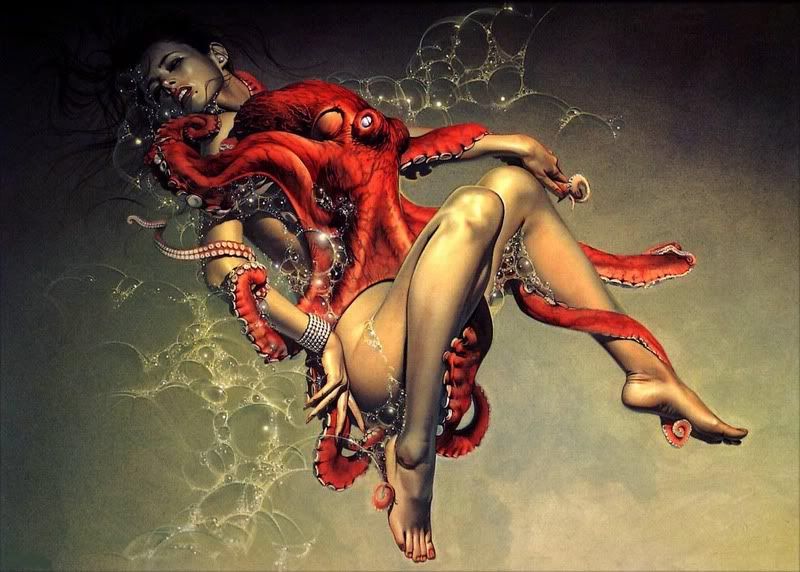
Galería de Hajime Soroyama
Biografía
Hajime Sorayama was born in 1947 in Ehime prefecture, Japan. Graduated from Imabari Kita High School in Imabari City. Sorayama entered Shikoku Gakuin University in 1965. majoring in English Literature. After the publication of PINK JOURNAL in 1967, he left the school and entered the Chuo Art School in Tokyo. Graduating in 1969, he was hired at an advertising firm Asahi Tsushin-sha in Tokyo as a comprehensive illustrator. He began working independently as a free-lance illustrator in 1972.
Labels: Artistas
Pulpos coleccionistas
Published Monday, November 07, 2005 by Spyder.Los pulpos suelen permanecer en sus cuevas durante casi todo el día con un ojo atento al exterior y a todos los movimientos que puedan registrarse en su territorio. La cueva le brindará protección adecuada durante el día y le permitirá descansar para salir a recorrer el arrecife en busca de presas cuando caiga la noche.
Coincidentemente la morena, su más temido enemigo, sale de cacería a la misma hora. La morena posee un delicado olfato que le permitiría llegar en la oscuridad hacia la guarida del pulpo. Es por eso muy beneficioso que a esa hora no se encuentre en casa. Al estar vagando por el arrecife y moviéndose permanentemente, los encuentros con las morenas resultan menos probables que estando quieto en un determinado lugar.
El pulpo tiene la extraña costumbre de recoger cosas del fondo marino y depositarlas en la entrada de su cueva. Trozos de colorido coral, conchas de caracoles y sobre todo cualquier cosa que brille, los elementos brillantes como el vidrio y el metal son los objetos preferidos de este curioso coleccionista. Cada día el pulpo dedica una gran atención a la limpieza de su colección. No es claro el motivo por los que junta y limpia estos objetos pero tal vez pueda tratarse de llamar la atención de los congéneres del sexo opuesto o advertir a los del mismo sexo de su presencia en la zona.
Los cazadores de pulpos conocen perfectamente esta costumbre, con sólo ver los objetos en la entrada de una pequeña cueva, saben de la existencia de un pulpo en su interior. Si los objetos en cuestión están parcialmente cubiertos por la arena sabrán que el pulpo abandonó la cueva pero si están limpios y ordenados el pulpo está ahí. Si un buzo se acercara a su cueva el pulpo no se inmutaría, por el contrario, lo observaría con atención. Pero si el buzo trajera en su mano un gancho de los que utilizan los cazadores para darle captura, inmediatamente el pulpo se internaría en la cueva tomando con sus poderosas ventosas una piedra, con el fin de tapar la entrada.
Desde hace unos años en las inmediaciones de Porto Belo, al sur de Brasil, donde la gran población de pulpos está muy cerca de la costa y en permanente contacto con cazadores, notamos una conducta que no deja de sorprendernos. Frecuentemente encontramos objetos limpios en una cueva donde no hay pulpos, eso significa que en una cueva cercana y a la vista de los objetos se encuentra el dueño de los preciados objetos. Aparentemente los pulpos de la zona aprendieron a poner su colección en una casa vacía pero no muy alejada de la propia para poder vigilarlos y mantenerlos limpios y ordenados.
Sin duda alguna los pulpos son animales sumamente inteligentes y dotados de un gran poder deductivo al punto tal de poder anticipar conductas humanas que, a veces, a nosotros mismos nos cuestan comprender.
Tito Rodriguez
Director Instituto Argentino de Buceo
Via Secretos del mar
Labels: Comportamiento
Sobre el comportamiento de los pulpos
Published Sunday, November 06, 2005 by Spyder.What behavior can we expect of octopuses?
Dr. Jennifer Mather, Department of Psychology and Neuroscience, University of Lethbridge and Roland C. Anderson, The Seattle Aquarium
Everyone agrees that the Cephalopods are unique among the invertebrates in the extent of their intelligence. Yet little is known about how they use that intelligence. Work since the studies of Young and Wells have shown that they learn well, that they keep the knowledge that they acquire and that they can make fine discriminations based on this learning. But what do they do with this learning, how do they use this capacity? There are alot of things that they do with their intelligence (see Mather, 1995, Advances in the Study of Behavior. 24, 316-353). Still, to talk about this use we have to use terms usually associated with vertebrates. Some of the terms now applied here for octopuses are navigation, tool use, personality and play.
NAVIGATION AND SPATIAL MAPS
Humans have known for thousands of years that the soft-bodied octopus uses different kinds of hiding places. Depending on the animal's size, these can be snail or clam shells, discarded beer bottles or sheltered niches in or under rocks. It has even been suggested that they build walls in front of the homes. But we've only recently realized that octopuses stay in these homes for periods of days and even weeks, that they go out to hunt and return home from quite a distance, sometimes after a long period of time. That makes the octopus a Central Place Forager, like many small mammals (see Stephen and Krebs, 1986, Foraging Theory). It also means that, like these mammals and some birds, they are using spatial memory to return home and they must be using some set of cues to navigate around their sea-bottom environment.
Mather traced young Octopus vulgaris in Bermuda on many of these hunting excursions and returns. In addition to going out and coming back home repeatedly, octopuses also seemed to cover different parts of their home range one after another on subsequent hunts and days (Mather, 1991, Journal of Comparative Physiology A 168, 491-497). This suggests they may have both Reference Memory for places where food might be found and Working Memory for where they had already hunted.
How do they navigate? Many snail species also go out foraging on the rocks, but they follow their outbound mucus trails to get back to their sheltered niche in a crevice (Chelazzi et al, 1985, Biological Bulletin 168, 214-221). Octopuses didn't do that, they often returned at a different angle from the one that they left the home by. Also, on long-distance returns they usually jetted mantle-first through the water. A series of disruptions of the foraging trail showed that they could make detours and suggested they were using vision to follow prominent features of the landscape of the rocky bottom. Lab studies of Octopus rubescens were difficult because the octopuses were intimidated by the open circular testing area, one of them never 'got used to it' and swam in panicked circles for a month of testing. However, results suggested that this species could learn to go to a landmark, and that they could also learn to head in a given direction to a place where the landmark had previously been.
The suggestion that octopuses navigate using spatial memory is a tantalizing one, but much more could be done to prove how it all works. Research on mammals, birds and insects such as bees has shown the cues that they learn to use and some of the mechanism behind the learning, the ways that they record and use the cues. There is a controversy as to whether each group relies simply on learning cues or whether they actually make a 'spatial map' inside their head to assist in finding their way around. With more work, we could ask the same questions of octopuses' navigation.
TOOL USE
With their eight long flexible arms and suckers to grasp small items, it would not be surprising that octopuses would manipulate their environment (J. Mather will have an article published this year in Journal of Comparative Psychology on the patterns ofactions and positions in use of the arms). One of the manipulations that used to be thought of as a human specialty is tool use. With more investigation, we have found that many animals, from fishing herons to ant-catching chimpanzees and egg-smashing vultures, use tools. Tool use is sometimes simple and fixed, not always a sign of intelligence, yet its range and flexibility gives us some indication when an intelligent animalis using this technique.
Beck (1980, Animal Tool Behavior: the Use and Manufacture of Tools By Animals) defined tool use precisely. To be a tool user, an animal had to modify, carry or manipulate an item that was external to itself before using it to effect some change on the environment. Mather first noticed octopuses using rocks as tools in a very simple way. Octopus vulgaris in Bermuda, occupying those homes mentioned above, often selected an area that wasn't 'perfect' in terms of size or area of opening. After settling in and clearing out sand, moving small rocks and pulling algae off the rocks, an octopus would often be left with a large entrance. It would go out from the home, pick up small rocks and bring them back to the home, piling them up at the entrance. By Beck's definition, these rocks were tools. When she correlated den opening area with number of rocks, there was a significant relationship—the bigger the hole, the more rocks were brought (Mather, 1994, Journal of Zoology 233, 359-368).
Thinking on the definition of tool use brought us to octopus water jetting. Molluscs have a water-filled mantle cavity, and all the Cephalopods have a muscular siphon to expel the water from this area. Squid use it very successfully for jet propulsion swimming, especially to escape from fish predators. But the octopus species in the family Octopoda in particular are not as streamlined. Their arms are larger and the jet of water has less propulsive force. What they do with water from this jet propulsion is use it in many different ways, including as a tool.
Remember the definition of tool use is to transport something external to the animal, to modify it somehow and to use it to effect a change on the environment or itself. Archer fish use water this way. They spit it from their mouth into the air and knock small insects off overhanging tree branches. When the insect falls into the water, the fish eats it. Octopuses also use water but in a variety of ways that change their environment.
One way octopuses use water as a tool is to change the niches that they find in the landscape to make them into suitable shelter, into homes. An octopus will find a 'likely' place, but it is usually clogged with sand and the shape may not be appropriate. It will gather sand and small rocks into the area under the arm web and carry them out to the entrance of the home. Once there, it will tilt up the web, let go with the suckers and jet it all away with a blast of water from the siphon. For a smaller amount of material it may not carry but just jet water at it, much as we would sweep with a broom.
A second way octopuses use water as a tool is to get rid of what could be described as nuisances. After capturing crab prey, the octopus will usually kill them and hold one or several under the arm web, dissolve the cartilage holding the joints together, digest out the meat, and keep the exoskeleton bits. When it's finished, it will take the remains to the den entrance and jet the lot out into what becomes a midden. If a scavenging Serranid fish comes by to eat these remains, the octopus may jet a blast of water to remove the 'pest' from the vicinity (Mather, 1992, Marine Behaviour and Physiology 19, 175-182). This water jet can be aimed also at a curious observer or researcher, as has happened to both of us when removing bits of prey remains to catalogue them, or just getting a hand too close to the octopus.
What all this means is that the octopus has a lot of flexibility in using the water all around it to change its environment, that it can compute the effect of what is really a current for respiration and use it in a lot of ways. We discovered that this water jet could be used in a behaviour that's really far from what is expected of an invertebrate. Octopuses can use the water jet to play, too.
PLAY
Like other terms covered here this one is expected to apply to vertebrates, almost always mammals and birds. Fagen (Animal Play Behaviour, 1981) describes play as similar to acts occurring infunctional contexts but exaggerated and more likely to contain repetitions, as well as having no immediate biological function. We took on the challenge of deciding whether the term might alsobe applied to the octopuses.
Play is an interesting area of behaviour, hard to define although we all know it when we see it. One category that seemed to apply to octopuses was exploratory play, including the manipulation of objects by an animal. With repeated exploration of an object, we hoped to see the octopuses change focus as Hutt described in Play, Exploration and Territory in Mammals (1966) from 'what does this object do?' to 'what can I do with this object?'. Octopuses are well known for exploring and manipulating objects, so this seemed a likely transition.
We gave Octopus dofleini at the Seattle Aquarium a simple object, a floating pill bottle that moved a little in the water in flow, to investigate during ten trials over five days. Notice that we didn't expect all the octopuses to play with it, because they have the individual variation that led us earlier to describe their 'personalities'.
If you are going to evaluate a controversial area of behaviour in a new group of animals, you have to set pretty clear criteria. We decided that to be playing with the bottle, an octopus would have to show a behaviour different from their first action, involving manipulation of the object, with simple actions and prolonged for over five minutes. All the octopuses grabbed the pill bottle and brought it to the mouth at the first trial, as if it were prospective food.
Several of the octopuses did something quite different on later trials in their series; they jetted water at the toy. This water manipulation is quite common for octopuses removing shell remains and nuisance scavengers, so that isn't automatically play. But two octopuses went farther. The saw the bottle circling in the intake gyre at the far end of the tank and aimed water jets that made it circle the tank and come back to them for further jets. One octopus set it up so that the toy circled the tank for around trip of 2 minutes, the other made a more direct return every 30 seconds. All instances continued over 10 minutes, and the longest was 23. If a human were doing this, someone would say we were bouncing a ball.
It's interesting that the water jet is what octopuses use for play. Why not the arms, which can move in any pattern they want? Maybe it is because the brain of the octopus doesn't need to get information about what the arms are doing, it's mostly local control. Maybe it is because no one has looked—the challenge is out there.
The differences in reaction of the eight octopuses reminded us that individual variation is so large that you can't really talk about 'the' octopus.
PERSONALITIES
Volunteers at the Seattle Aquarium were the ones who gave Anderson a clue that octopuses were so different from one another. They gave names to individuals of only three species of all the animals there, and one was the octopuses. There were some interesting names, like Lucretia McEvil and Devil and Emily Dickinson. Again, there have been studies of personalities in animals but they are usually on mammals, although there have been studies on fish, too (see the Handbook of Comparative Psychology, which is to be published in a couple of months, for an entry on Individual Differences by Mather).
Testing for individual difference is a contrast to the usual lab investigation. Instead of giving animals different trials and experimental conditions and looking for average response, you give them all simple situations and look for differences in responses. We chose Octopus rubescens and gave them the situations of Alerting (by opening the tank lid), Threat (bytouching them with a probe) and Feeding (by giving them a crab).
We recorded nineteen behaviours in three situations and put them to some formidable tests. To find variation, you submit the numbers to factor analysis and then principal components analysis. The results sort into groups of responses and these predict Dimensions on which individuals vary. The choice of names is subjective, but the octopuses varied on three dimensions that we chose to call Activity, Reactivity and Avoidance (they are similar to those found in fish and mammals). We could take any octopus and make a 'personality profile' for it on these dimensions (see the article in Journal of Comparative Psychology 107, 336-340, 1993).
Does this mean octopuses have personalities? The answer is a qualified yes. The difference seemed to be long-lasting, but we didn't study that. We don't know anything about where the differences come from. Was a shy octopus scarred by experiences in the planktonic stages? Or is it strongly due to genetic heritage, as Burghardt (1974, Behaviour 52, 202-225) found for snakes? What difference does it make to foraging success, habitat preference, ability to find a mate? There's lots to learn.
One thing we have thought of is that this variability may underline much of what has been shown above about octopus intellectual capacity. Without the differences, octopuses could not adapt and learn. Individual differences are very useful fora soft-bodied animal like the octopus that has to live by its wits. They also help individuals track a varying environment (see The Beak of the Finch by Weiner (1995) for an excellent demonstration on birds in the Galapagos). The underwater near-shore environment is very varied, especially in the tropical coral reefs. The ability to do new behaviours or see things in new ways may allow the octopus to navigate around the bottom, too bserve others, to use tools and even to play, and thus to thrive even when it seems to have little protection against predators.
What next? There's a lot out there to do. While octopuses are solitary, some of the squid are not; what's their social organization? There are questions just touched and still unresolved as to whether squid and octopuses recognize each otheras individuals and whether they recognize individual humans. We have been getting more interested in the communication system they set up by changing colours and patterns on their skin. There is a whole area of tactile and chemical recognition, just skimmed because we humans are such visual animals and so haven't studied it much or well. If octopuses don't use vision much forfinding prey, what are the cues and how are they used? And there's an intriguing question of how much octopuses know where they are and even what their arms are doing. There's lots to do!
Text on this page was written by J. Mather and R. Anderson.
Articles Reference
Mather J. A. and Anderson R. C. 1998 What behavior can we expect of octopuses? In: The Cephalopod Page. Wood, J. B. Ed.
Labels: Comportamiento
Poema de Gioconda Belli -Eros es el agua-
Published Friday, November 04, 2005 by Spyder.EROS ES EL AGUA
Entre tus piernas
el mar me muestra extraños arrecifes
rocas erguidas corales altaneros
contra mi gruta de caracolas concha nácar
tu molusco de sal persigue la corriente
el agua corta me inventa aletas
mar de la noche con lunas sumergidas
tu oleaje brusco de pulpo enardecido
acelera mis branquias los latidos de esponja
los caballos minúsculos flotando entre gemidos
enredados en largos pistilos de medusa.
Amor entre delfines
dando saltos te lanzas sobre mi flanco leve
te recibo sin ruido te miro entre burbujas
tu risa cerco con mi boca espuma
ligereza del agua oxígeno de tu vegetación de clorofila
la corona de luna abre espacio al océano
De océano los ojos plateados
fluye larga mirada final
y nos alzamos desde el cuerpo acuático
somos carne otra vez
una mujer y un hombre
entre las rocas.
GIOCONDA BELLI
(Managua, Nicaragua, 1948)
Nació en Nicaragua, en 1948, destaca en las letras hispanoamericanas contemporáneas. Fresca y vitalista, profundamente personal, tiene un estilo que escapa a cualquier corriente o escuela. Erótica, feminista y revolucionaria, su voz sincera es un salto hacia el mundo.
Gioconda Belli ha incursionado en la poesía con libros como: Sobre la grama (1974), Línea de fuego (Premio Casa de las Américas, 1978), Truenos y arcoiris (1982), La costilla de Eva (1987) y El ojo de la mujer (1991).
Labels: Literatura, Poemas
Arte y pulpos -Tako Karakusa-
Published by Spyder.La presencia de los pulpos en la cultura japonesa es lo suficientemente importante para haberse inmirscuido en la tradición milenaria que constituye la fabricación de cerámica (ya hablamos de los rakus). Existe un motivo ornamental que lleva el nombre de Tako Karakusa que representa un arabesco de forma espiral; como ya he dicho en otras ocasiones, Tako en japonés significa pulpo.
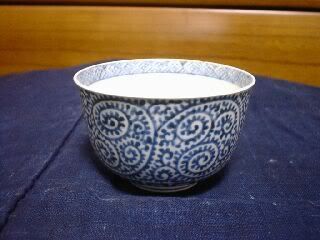
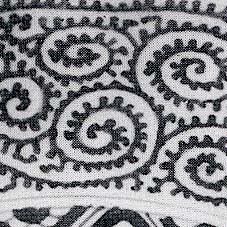
Labels: Artistas, Foto Arte, Mitología, Publicidad
Hentai tentacular -Tentacle rape-
Published Thursday, November 03, 2005 by Spyder.Si dentro de sus parafilias está la octofilia, tal vez les interese este artículo de la wikipedia, sobre las violaciones tentaculares tan comunes en el hentai japonés.
Tentacle rape
Vía Wikipedia
Tentacle rape is a concept found in some horror hentai titles, where various tentacled creatures (usually fictional monsters) rape or otherwise penetrate young, big-breasted women (or, less commonly, men). Much of the genre also consists of domination/humiliation and bondage fetishes, since the "victim" is typically restrained by the appendages. Biological justifications are sometimes given; the tentacle creature may be described as a parasite who deposits its eggs into a female for breeding. In other unlikely scenarios the creature outright impregnates its victim.
Tentacled creatures appeared in Japanese erotica long before animated pornography; among the most famous of the early instances (and perhaps the first) is a Hokusai (the original creator of the word manga) woodcut called The Dream of the Fisherman's Wife, depicting a woman sexually entwined with a pair of octopuses. This woodcut arose in the Edo period in Japan when Shinto was making a resurgence; the resulting animism and a more playful attitude to sexuality combined powerfully in Hokusai's piece. It is a celebrated example of shunga and has been reworked by a number of artists. Australian artist David Laity reworked the woodcut into a painting of the same name, and Masami Teraoka brought the image up to date with his 2001 work "Sarah and Octopus/Seventh Heaven", part of his Waves and Plagues collection.
Another example of pre-animation tentacle porn is the 1933 sci-fi short story "Shambleau" by author C.L._Moore. While the creature in the story is more vampiric than licentious, the elements of the narrative would be recognizable to anyone familiar with the genre.
Toshio Maeda's manga Urotsukidoji created what might be called the "modern paradigm" of tentacle porn, in which the elements of sexual assault are emphasized. Maeda explained that he invented the practice to get around strict Japanese censorship regulations, which prohibit the depiction of the penis but apparently do not prohibit showing sexual penetration by a tentacle or similar (often robotic) appendage.
Examples include:
The Urotsukidoji Saga — Started in 1987, the Overfiend series is the most well-known title in the genre.
La Blue Girl — a series of films that moved from animation to live action. Famous for being refused translation outright by the British censor.
Injukyoshi ("Obscene Beast Teacher") — a live action film.
Alien from the Darkness and Advancer Tina — Hentai films about female explorers battling tentacled aliens.
At times, the genre also seems to exploit the more controversial realms of bodice ripper genre, particularly rape fantasies, with the "safety" that the scenes being depicted are so absurd or fanciful they do not have parallels in the real world. Some fans see it as the extreme of bodice-ripping stories, although the rape fantasy genre is seen more critically in the West than in native Japan.
The topic is also ripe for parody, as shown by the following:
alt.sex.cthulhu and a range of other Cthulhu-related web pages
Many different web comics and cultural groups on the internet reference "tentacle pr0n" in a humorous way. An example is Ghastly's Ghastly Comic, in which it is a frequently recurring topic.
"The Lighter Side of Tentacle Hentai", from Sexy Losers

Pulpos y música -Tango- Pulpo Viejo-
Published Wednesday, November 02, 2005 by Spyder.La milonga aunque viene emparentada con el tango, tiene unas diferencias de tipo formal en el diferente compás. Pero existe otra diferencia más curiosa, y es que la milonga tiene las letras más divertidas mientras que el tango suele ser más melancólico. Es por ello que Borges siempre se declaró más cercano a la alegría que emana la milonga.
Miren si no esta milonga, dedicada a al jockey Ireneo Leguisamo (del cual hablabamos hace unos posts) compuestra por Jorge Vidal, en la que se queja porque Ireneo Leguisamo siempre tiene la manía de fastidiarle sus apuestas.
PULPO VIEJO
Letra: Jorge Vidal
Interprete: Jorge Vidal
No es que quiera criticar,
pero viejo leguisamo,
yo sufro como un enano,
cuando te entras a hamacar,
la fiebre me haces pasar,
aunque me gusta tu pingo,
y asi empiezo otro domingo,
porque con vos no hay tu tia,
de entrada estoy en la via,
poniendo cara e' gilito.
si te juego a vos perdes,
si juego en contra ganas,
yo no se lo que tendras,
siempre te emboco al reves,
de la cabeza a los pies,
metido estoy y me meto,
prometeme y te prometo,
que siempre te he de jugar,
si vos me hicieras quebrar,
te guardo "legui" el secreto.
total que te importaria,
ganar las ocho carreras,
mientras yo de la "perrera",
boletos te sacaria,
la gilada miraria,
mi manera de embocar,
!anda!, no te hagas rogar,
sacame del duro brete,
si una vez ganaste siete,
una mas ni la notas.
pero si vos no queres,
que se levante un echado,
!anda!, no estoy amargado,
no son reproches, sabes,
yo se bien cuanto vales,
lo sabe bien la tribuna,
y aunque no ganes ninguna,
en la proxima reunion,
yo estare entre la legion,
a ver si te emboco una.
Labels: Música
